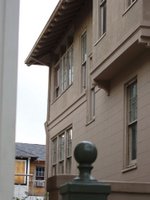Tuesday, September 05, 2006
A Small Tour of a New Orleans Neighborhood, Part 3
 This installment of the tour is more of a mixed bag than Part I and Part II. It may even be a little redundant in places. That's the danger of reading a blog: It's not always a professionally polished product.
This installment of the tour is more of a mixed bag than Part I and Part II. It may even be a little redundant in places. That's the danger of reading a blog: It's not always a professionally polished product.See that second floor room up under the eaves near the back of the house in the foreground? With three side-by-side windows? That was my room when I was a child in 1965. It's a corner room and there is another row of windows on the side around the corner. The house also has an above-ground basement apartment so it's actually three stories up. '65 was the year Hurricane Betsy hit New Orleans. In NOLA, hurricanes are always measured by the worst ones in recent memory. Before Betsy, it was Hurricane Audrey in 1957. After Betsy, it was Hurricane Camille in 1969. These are the hurricane epochs I remember hearing about in my childhood.
Back to Betsy: Because of the exceptionally exposed nature of my room, I stayed in my sister's room for the night. The two corner walls had a lot of glass which was likely to blow in during the storm. The next morning when we looked into my room, none of the panes of glass had broken. One had cracked but that was all. However, the roof had leaked into the ceiling, soaking it until a huge section of the plaster had given way and fallen directly onto the head of my bed. Wet plaster is heavy. Would its fall have killed me? It's hard to say for certain but it's quite possible. I never thought much about it afterwards. It was just part of the hurricane experience in NOLA.
Why tell you this poignant story of my youth? Because it illustrates the adaptive nature of NOLA residents when it comes to hurricanes. These were the shared historical markers, the communal experiences. Like the deaths of JFK, John Lennon or Kurt Cobain (depending on your generation) on the national level, people of NOLA remember the hurricanes of their lives and what they were doing when they hit New Orleans.

When I first toured the Broadmoor area, it seemed like there was a lot of garbage on the curbs. I wondered how often the city was picking it up. Over the course of my stay I discovered, at least in the Broadmoor area, the garbage was being collected regularly. I would see collections like the one here. Then they would disappear, only to quickly build up again. The detritus of stripping houses and remodeling would go out whenever and stay there for days. There was no sense in waiting for a specific garbage day; stuff was taken out when the muscle and people able to lift it were available. It would then sit on the curb. There were specific trucks that came around and got the heavy stuff like appliances, lumber, sheetrock. Bobcat loaders accompanied them to shovel up the stuff and put it in the big trucks.

Many/most corners in NOLA sport signs like these on the electrical poles with ads for mold removal, roofing, renovation, etc. You can see another blue tarped roof in the background. There are services that will print up hundreds of these things. They are made of a rigid plastic, thicker than "For Sale" or "Closed" signs you can buy in hardware stores.

It's these little things I notice. Like this temporary stop sign on a corner in an Uptown residential neighborhood almost a year after the hurricane. Of course there are other priorities, much more important items needing to be taken care of than the replacement of a few stop signs. Yet it's just another reminder of the very lack of normalcy permeating the environment.
I didn't really get to all of the photos I wanted to share here but maybe I'll upload them to my flickr account. Yeah, I'll put them all there under the title "New Orleans, August 2006". So click through if you want to see more of them.
 The CR FAQ - An Introduction to Celtic Reconstructionist Paganism
The CR FAQ - An Introduction to Celtic Reconstructionist Paganism





